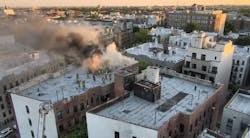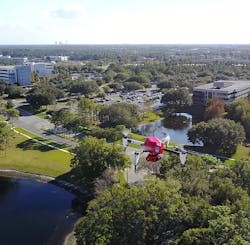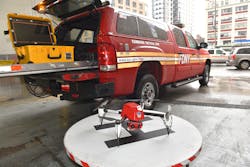In the fire service, the use of small unmanned aircraft systems (sUAS), more commonly referred to as drones, has matured from a slow birth to a rapid expansion of unquestionable operational worth over the last two decades. Today, public safety agencies around the world are deploying drone technology with varying rates of success.
There are many components to a public safety drone program that can seem daunting to pull together, and particularly difficult in big cities, where there are unique challenges to the safe implementation of drones. Specifically, tall buildings, wind effects, radio frequency interference, large population masses and congested air space add to the already cumbersome list of challenges to starting a public safety drone program.
The following is an account of the FDNY’s journey in embracing this emerging technology and how our program has matured. Growth is dynamic and will continue to evolve with the fast pace of the industry, leaving many to speculate on what the future may hold and how the fire service may utilize and benefit from drone technology.
Birth of the program
I was invited to sit in on a meeting at the FDNY’s Research and Development building about drones with the Federal Aviation Administration (FAA) sometime in 2014. I was familiar with the technology, as I had already owned an early-model drone, and I will certainly self-identify as a “gadget guy.”
A few months later at a full-scale urban search and rescue (USAR) exercise at the Guardian Center in Georgia, I had the opportunity to operate my early-model drone during a collapse scenario. While I previously studied other public safety agencies that had already embraced this new technology, this was my chance to experience drone deployment in a realistic setting for myself.
In a 10-minute flight, I was able to identify the locations of 11 victims, the best route to get to each of them, the structural stability of damaged buildings, as well as any other dangerous hazards that existed. I was immediately convinced that this technology would have a profound impact on fire and emergency operations. What stood out most were these key facts:
• I could easily collect and relay this essential information to the Command staff in far less time than it would have taken by traditional methods; and
• This reconnaissance was accomplished with no risk to human rescue teams.
After landing my drone, I noticed another drone operating in the vicinity with a long tether attached. This tethered drone was being operated by a vendor demonstrating its capabilities to our Fire Department Operations Center (FDOC). The FDNY FDOC operates a command center that allows for staff chiefs to stay on top of evolving fire and emergency situations on a daily basis in New York City. The Command Tactical Unit (CTU) broadcasts a live video feed of incidents to the FDOC as well as to a tablet that is supplied to the incident commander (IC) for real-time situational awareness. This was traditionally performed with ground cameras and extended pole cameras, but with this new tethered drone, reaching heights of 200 feet allows for a much broader and detailed view of an incident. This would be the beginning of the FDNY’s drone program.
Tethered—and now untethered—drones
Tethered drones allowed the FDNY to safely begin a drone program at a time where there were reliability concerns about using radio frequency-operated drones, particularly in densely populated urban settings. We were faced with the paradox of having no data to support safe flight, and without that data, we couldn’t fly to collect the data. In the “crawl-walk-run” model, the FDNY officially crawled into having a drone program that was both reliable and safe.
Tethered drones offer risk mitigation to the major challenges that public safety drone programs face in urban settings, such as radio frequency interference, tall dense buildings, congested air space, ground congestion and privacy concerns. But a dedicated tethered system also has its weaknesses. (See the sidebar Tethered Drone System Pros & Cons.)
The members of the FDNY involved in the drone program receive many questions about our program and there are quite a few directed at our tethered system. Most FDNY pilots would agree that a tethered drone has a key role in our operational capabilities especially with long-term incidents, but that we also need to expand on those capabilities.
As we continue to enhance our program, in the last few months, the FDNY was officially given permission to operate untethered drones in New York City by our City Hall. The FDNY had already been in possession of a certificate of authority from the FAA to operate this way for a couple of years, so this completed the process to begin the “part two” in our history.
As noted, the CTU operates daily, providing ICs and Command staff with thermal and visual data to assist in the process of tactical decision making while providing another layer of operational safety to our members. The highly skilled FDNY CTU remote pilots are experienced in operating in New York City’s challenging urban landscape and always utilize a visual observer (VO) to achieve a safe and successful mission.
Key considerations
As with most technology, drone technology is moving at such a fast pace that it is difficult to keep current, both administratively and operationally. If you purchase the latest and greatest, you will soon find a newer model with improved features on the market in months, if not weeks. Further, FAA regulations are constantly changing to improve public safety operations.
The good news: We now have more data that supports the safe and reliable operations of untethered drones. Radio frequencies are stronger and more reliable, battery and motor improvements match better with higher wind speeds, new multi-global navigation satellite system receivers improve positioning, parachute systems add another layer of safety, fail safe features are robust with more options, and the latest battery technology improves flight times. A comprehensive risk assessment, technological advances and a layered safety approach are necessary elements to embrace the aviation industry’s remarkable safety culture while operating in the national airspace.
Critical support
We have worked extensively with partners, such as the National Institute of Standards and Technology (NIST), so that testing standards could be enhanced and applied to evaluate systems, and the data that we collect adds to a growing body of literature validating drone applications for use in the public safety sector, ensuring that NIST is an invaluable resource for platform evaluation and procurement. The FDNY will continue to work with our public safety partners and stakeholders to improve drone operations and begin to adopt the best practices that emerge from the collective experience of all agencies.
Preview of the future
The future of the FDNY’s drone program may include multiple units with many different platforms to meet new mission objectives. The inclusion of ground robotics and remotely operated marine vehicles into a centralized program may optimize operational worth and efficiency to achieve economies of scale.
As other technology continues to miniaturize and become more affordable, such as light detection and ranging (LiDAR) and atmospheric monitoring, we will see a growth in operational reliability as well as an expansion of mission capabilities. On the software side, artificial intelligence (AI) and augmented reality will be major enhancements increasing the operator’s ability to process large amounts of data.
FDNY drones will continue providing ICs with more data to make effective real-time decisions while slowly introducing tactical operations into our mission capabilities.
Sidebar 1: Tethered Drone System Pros & Cons
Following are some of the pros and cons that the FDNY has learned from operating a dedicated tethered drone system.
Pros
- No radio frequency issues
- Secure data from aircraft to ground station
- Much longer flight duration
- Less operational work area to secure
- Minimizes air traffic concerns by limiting range
Cons
- Limited mobility
- Limited mission capabilities
- Limited emergency controls
Sidebar 2: FDNY Drone Program Facts
- Following are some interesting facts about the FDNY’s drone program:
- First flight: Bronx Fourth Alarm - March 6, 2017
- Response: Second alarms or greater plus special calls
- Personnel: One officer and two members per shift, 24/7
- Vehicle: Crew cab pickup with cap
- Video transmission: Bonded cellular
- Quarters: FDOC at Brooklyn Headquarters
About the Author
Michael Leo
Michael Leo is a captain with the FDNY. While earning a bachelor’s degree in fire and emergency management at John Jay College, Leo studied the expanding role of unmanned aircraft systems (UAS) for use in emergency management. He has presented his work at the NFPA annual conference, AUVSI XPOTENTIAL conference and the International Research Society for Public Management’s annual conference in Budapest, Hungary. Leo represents the FDNY as a member of the NFPA 2400 technical committee, the National Council on Public Safety for UAS and several robotic joint-working groups.


